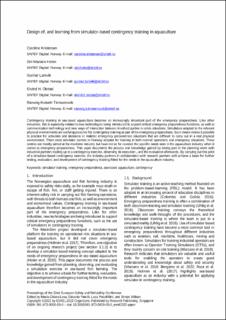| dc.contributor.author | Kristensen, Caroline | |
| dc.contributor.author | Holen, Siri Mariane | |
| dc.contributor.author | Lamvik, Gunnar Martin | |
| dc.contributor.author | Okstad, Eivind Halvard | |
| dc.contributor.author | Tinmannsvik, Ranveig Kviseth | |
| dc.date.accessioned | 2023-03-01T15:26:17Z | |
| dc.date.available | 2023-03-01T15:26:17Z | |
| dc.date.created | 2022-11-29T16:54:40Z | |
| dc.date.issued | 2022 | |
| dc.identifier.citation | Proceedings of the 32nd European Safety and Reliability Conference (ESREL 2022). 2022, 473-479. | en_US |
| dc.identifier.isbn | 978-981-18-5183-4 | |
| dc.identifier.uri | https://hdl.handle.net/11250/3055102 | |
| dc.description.abstract | Contingency training in sea-based aquaculture becomes an increasingly important part of the emergency preparedness. Like other industries, this is especially related to new technologies being introduced to support critical emergency preparedness functions, as well as communication technology and new ways of interaction between involved parties in crisis situations. Simulators adapted to the relevant physical environments are useful approaches for contingency training as part of the emergency preparedness. Such means makes it possible to practice for activities and decisions in realistic emergency preparedness situations that are difficult to carry out in a real physical environment. There exist simulator centres in Norway adapted for training in both normal operations and emergency situations. These centres are mostly aimed at the maritime industry but have not so far covered the specific needs seen in the aquaculture industry when it comes to emergency preparedness. This paper documents the process and knowledge gained by taking part in the planning work with industrial partners leading up to a contingency exercise, observing its execution-, and the evaluation afterwards. By carrying out this pilot of a simulator-based contingency exercise, the industry partners in collaboration with research partners will achieve a basis for further testing, evaluation, and development of contingency training fitted for the needs in the aquaculture industry. | en_US |
| dc.language.iso | eng | en_US |
| dc.publisher | Research Publishing Services | en_US |
| dc.relation.ispartof | Proceedings of the 32nd European Safety and Reliability Conference (ESREL 2022) | |
| dc.relation.uri | https://www.rpsonline.com.sg/proceedings/esrel2022/html/toc.html | |
| dc.subject | Havbruk | en_US |
| dc.subject | Aquavulture | en_US |
| dc.subject | Beredskapsøvelse | en_US |
| dc.subject | Emergency exercise | en_US |
| dc.subject | Simulatortrening | en_US |
| dc.subject | Simulator training | en_US |
| dc.subject | Beredskap | en_US |
| dc.subject | Emergency preparedness | en_US |
| dc.subject | Fiskeoppdrett | en_US |
| dc.subject | Fish farming | en_US |
| dc.title | Design of, and Learning from Simulator-based Contingency Training in Aquaculture | en_US |
| dc.type | Chapter | en_US |
| dc.description.version | publishedVersion | en_US |
| dc.rights.holder | Copyright © 2022 by ESREL2022 Organizers. | en_US |
| dc.source.pagenumber | 473-479 | en_US |
| dc.identifier.doi | 10.3850/978-981-18-5183-4_R12-06-087 | |
| dc.identifier.cristin | 2084573 | |
| dc.relation.project | Norges forskningsråd: 309305 | en_US |
| cristin.ispublished | true | |
| cristin.fulltext | original | |
| cristin.qualitycode | 1 | |
